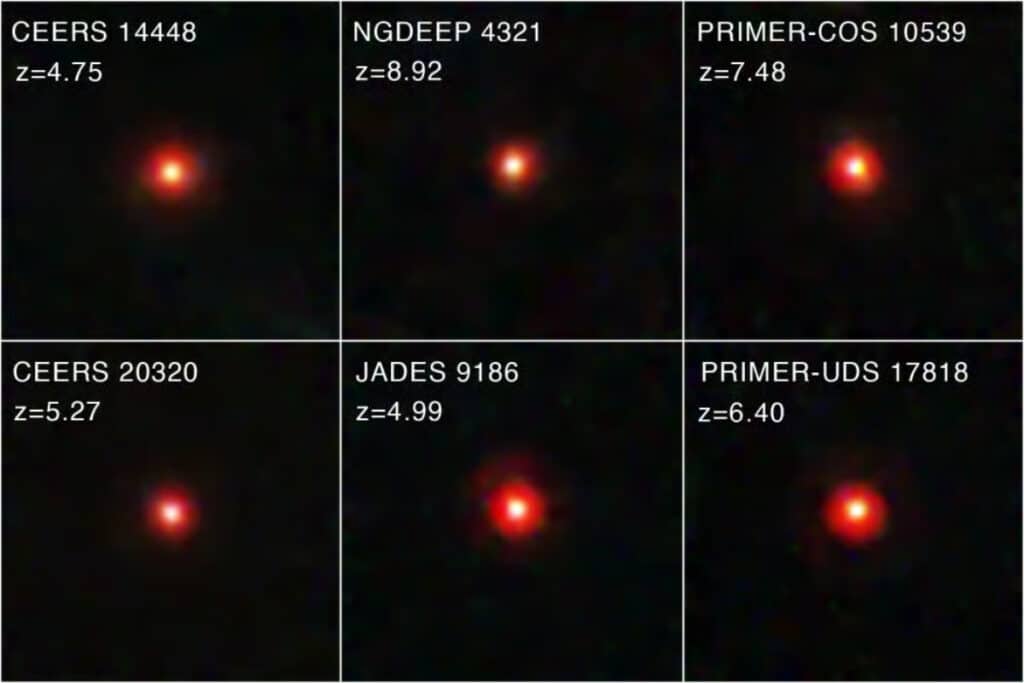The James Webb Space Telescope has picked up some mysterious red glimmers from the far reaches of the universe. But don’t be fooled — they might not be tiny lights at all, but colossal black holes and other massive cosmic giants.
Scientists have been scratching their heads over these curious red dots, which have been tucked away in the telescope’s data since almost the beginning. Born just a few hundred million years after the Big Bang, these lights have sparked study after study — and the latest one may finally have an answer.
Published in The Astrophysical Journal, the research suggests these seemingly small, tidy specks are actually sprawling, odd-shaped structures with no clear edges.
Not all red dots are what they seem
A team of researchers took a closer look at 99 of these red dots and found they’re far from uniform. When viewed in ultraviolet, the reality behind their visible light appearance is dramatically different — they morph into strange, shapeless structures that defy the neat little dot image we had in mind.

The small red dots observed by the James Webb are of various kinds. © ESA, NASA
Thanks to Webb’s sharp UV vision, many of the dots appear more like irregular smudges than precise points of light.
That in itself is peculiar. Most celestial objects don’t change character like that across wavelengths. And since nearly a third of the dots showed this behavior, the scientists are fairly certain it’s not just cosmic dust playing tricks. Instead, they suspect powerful interactions in the surrounding environment are at play.
Some may hide black holes, others newborn stars
One of the study’s authors, Pierluigi Rinaldi, shared via Nova University in the Netherlands: “In the spectrum of some of these little red dots, we directly detect the signatures of active black holes, with gas moving at thousands of kilometers per second.”
Still, not every dot tells the same story. Some clearly show the mark of black hole activity. Others? They seem more in line with processes involved in star formation.
Interestingly, a previous study also pointed to black holes but with a twist — it proposed the existence of “black hole stars.” These are theoretical beasts that devour matter like a black hole, but instead of vanishing it, they convert it into energy, shining even brighter than a typical star. And from across the universe, they’d show up as tiny red dots.

The small red dots aren’t really dots. © P. Rinaldi, Jades, NASA
What if our models are missing something?
The new findings neither confirm nor debunk that black hole star idea. What they do reveal, though, is that the odd shapes of these dots point to strong forces interacting — possibly black holes, massive stars, or even galaxies on a collision course.
Here’s the twist: only 30% of the dots fall into this fuzzy-shape category. The remaining 70%? They appear neat and compact, even under ultraviolet scrutiny. And spectral analysis hints that at least some of them also host supermassive black holes.
This is where the black hole star theory shines again — it provides a plausible way to explain the existence of such huge objects born so soon after the Big Bang. It’s a paradox that’s been tripping up cosmological models for decades.
That said, there’s only so much even the mighty James Webb can tell us. These dots lie unimaginably far away, and high-resolution data can only go so far. What we do know is that the region they inhabit is brimming with activity — enough to warp light and structure into forms we still don’t fully understand.
Whatever’s going on out there, it’s pushing the boundaries of how we think the universe works

Hugo Ruher
Science journalist
Science journalist, I am above all passionate about space, which is what inspired me to pursue this specialty. Drawn to science in general, I also closely follow news related to the environment and technology.
After earning a degree from Sciences Po Toulouse, I began working in radio, covering general news, international issues, and even local problems. At the same time, I started a career as a science journalist, first focusing on space and later on environmental topics.
Making complex information simple
A large part of my work involves reading scientific studies published in various journals, texts that are often complex or downright indigestible! My goal is to extract information from them and make it accessible to a broader, non-expert audience. This ambition is what truly drives me.
This path has led me to write for teen magazines like Cosinus, highly specialized publications such as Industrie & Technologies, as well as more mainstream outlets like Numerama or Le Monde.
In addition to that, I also sometimes write about topics that are a bit more “lightweight.” The digital world, ranging from the use of social media to AI, and even the culture around video games—are areas that I find fascinating and worth covering with a serious approach.


